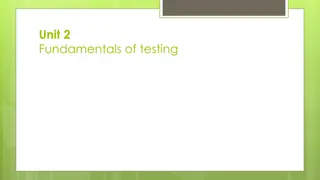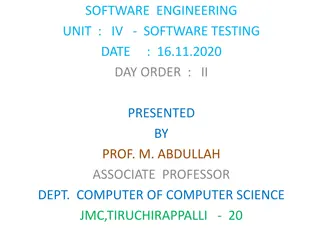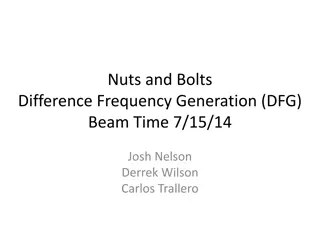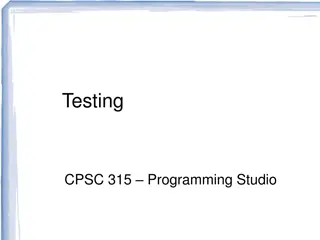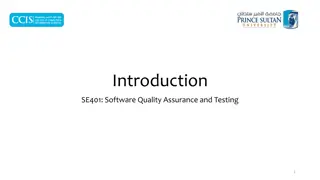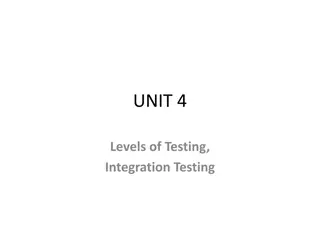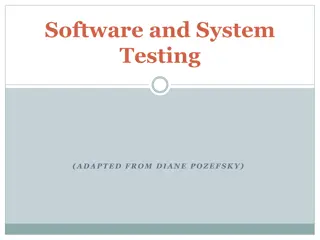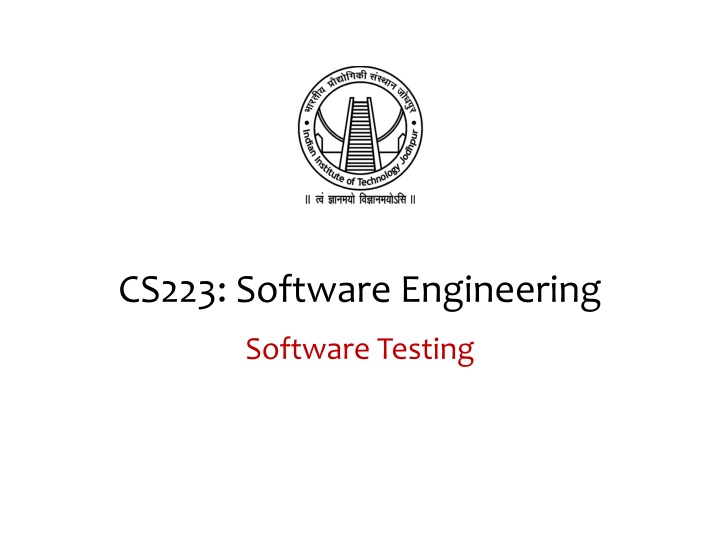
Effective Software Testing Techniques Overview
Learn about software testing strategies including dynamic unit testing, debugging methods, extreme programming, test planning, and control flow testing for efficient software development and bug detection.
Download Presentation

Please find below an Image/Link to download the presentation.
The content on the website is provided AS IS for your information and personal use only. It may not be sold, licensed, or shared on other websites without obtaining consent from the author. If you encounter any issues during the download, it is possible that the publisher has removed the file from their server.
You are allowed to download the files provided on this website for personal or commercial use, subject to the condition that they are used lawfully. All files are the property of their respective owners.
The content on the website is provided AS IS for your information and personal use only. It may not be sold, licensed, or shared on other websites without obtaining consent from the author.
E N D
Presentation Transcript
CS223: Software Engineering Software Testing
Dynamic Unit Testing A test driver is a program that invokes the unit under test. The test driver and stubs are tightly coupled with the unit under test and should accompany the unit throughout its life cycle. A stub is a dummy subprogram that replaces a unit that is called by the unit under test (Does two things )
Testing vs. Debugging After a program failure, identify the corresponding fault and fixes it. Debugging : The process of determining the cause of a failure. Debugging occurs as a consequence of a test revealing a failure. Approaches to Debugging o Brute Force Let the computer find the error o Cause Elimination Induction and deduction o Back Tracking
Test planning and design To get ready and organized for test execution Provides a framework, scope, details of resource needed, effort required, schedule of activities, and a budget During test plan o The system requirements are critically studied, o System features to be tested are thoroughly identified, o The objectives of test cases and the detailed behavior of test cases are defined
Selection of Test Data Control Flow Graph Data Flow Graph Control Flow Data Flow Functional Program Domain Special values from i/o domain Domain Error
Control Flow Testing Program instructions are executed in a sequential manner o In the absence of conditional statements o Unless a function is called The execution of a sequence of instructions from the entry point to the exit point of a program unit is called a program path. Ideally, one must strive to execute fewer paths for better effectiveness.
Outline of control flow testing Inputs o The source code of a program unit o A set of path selection criteria Examples of path selection criteria oSelect paths such that every statement is executed at least once oSelect paths such that every conditional statement evaluates to true and false at least once on different occasions
Control Flow Graph (CFG) The idea behind checking the feasibility of a selected path is to meet the path selection criteria
Control Flow Graph (CFG) FILE *fptr1, *fptr2, *fptr3; /* These are global variables.*/ int openfiles(){ /* This function tries to open files "file1", "file2", and "file3" for read access, and returns the number of files successfully opened. The file pointers of the opened files are put in the global variables. */ int i = 0; if( ((( fptr1 = fopen("file1", "r")) != NULL) && (i++) && ((( fptr2 = fopen("file2", "r")) != NULL) && (i++) && ((( fptr3 = fopen("file3", "r")) != NULL) && (i++)) (0)) || (0)) || ); return(i); }
Control Flow Graph (CFG)
What paths do I select for testing? Select all paths. Select paths to achieve complete statement coverage. Select paths to achieve complete branch coverage. Select paths to achieve predicate coverage.
What paths do I select for testing? Select all paths. Select paths to achieve complete statement coverage. Select paths to achieve complete branch coverage. Select paths to achieve predicate coverage.
Path selection criteria FILE *fptr1, *fptr2, *fptr3; /* These are global variables.*/ int openfiles(){ /* This function tries to open files "file1", "file2", and "file3" for read access, and returns the number of files successfully opened. The file pointers of the opened files are put in the global variables. */ int i = 0; if( ((( fptr1 = fopen("file1", "r")) != NULL) && (i++) && ((( fptr2 = fopen("file2", "r")) != NULL) && (i++) && ((( fptr3 = fopen("file3", "r")) != NULL) && (i++)) (0)) || (0)) || ); return(i); }
Paths executed by the test inputs 1. <No, No, No> 2. <Yes, No, No> 3. <Yes, Yes, Yes >
What paths do I select for testing? Select all paths. Select paths to achieve complete statement coverage. Select paths to achieve complete branch coverage. Select paths to achieve predicate coverage.
Statement Coverage It refers to o Executing individual program statements and o Observing the outcome. 100% statement coverage has been achieved if o All the statements have been executed at least once Covering a statement in a program means o Visiting one or more nodes in a CFG
What paths do I select for testing? Select all paths. Select paths to achieve complete statement coverage. Select paths to achieve complete branch coverage. Select paths to achieve predicate coverage.
P1 P2 P1 P2 CFG P2 P1 P2 P2 P1 P2 P2 P2 P1 P2 P2 P1 P2 P2 P1 P2 P2 P2 P2 P2 P1 P2 P2
What paths do I select for testing? Select all paths. Select paths to achieve complete statement coverage. Select paths to achieve complete branch coverage. Select paths to achieve predicate coverage.
Generating test input How to select input values, such that o When the program is executed with the selected inputs o The chosen paths get executed 1. Input Vector 2. Predicate 3. Path Predicate 4. Predicate Interpretation 5. Path Predicate Expression 6. Generating Input Data from Path Predicate Expression
Input Vector It is a collection of all data entities Members of an input vector of a routine can take different forms o Global variables and constants o Files o Contents of registers
Predicate A predicate is a logical function evaluated at a decision point The construct OB is the predicate in decision node 5
Path Predicate A path predicate is the set of predicates associated with a path. We must know whether the individual component predicates of a path predicate evaluate to true or false in order to generate path forcing inputs.
Predicate Interpretation The local variables are not visible outside a function We can easily substitute all the local variables in a predicate with the elements of the input vector The process of symbolically substituting operations along a path in order to express the predicates solely in terms of the input vector and a constant vector.
Path Predicate Expression An interpreted path predicate is called a path predicate expression o It is void of local variables o Path forcing input values can be generated by solving the set of constraints in a path predicate expression. o If the constraints can not be solved: infeasible path
CFG Testing 1. Input Vector 2. Predicate 3. Path Predicate 4. Predicate Interpretation 5. Path Predicate Expression 6. Generating Input Data from Path Predicate Expression
1. Draw a CFG for binsearch(). 2. From the CFG, identify a set of entry exit paths to satisfy the complete statement coverage criterion. 3. Identify additional paths, if necessary, to satisfy the complete branch coverage criterion. 4. For each path identified above, derive their path predicate expressions. 5. Solve the path predicate expressions to generate test input and compute the corresponding expected outcomes. 6. Are all the selected paths feasible? If not, select and show that a path is infeasible, if it exists. 7. Can you introduce two faults in the routine so that these go undetected by your test cases designed for complete branch coverage?
Data Flow Testing A memory location corresponding to a program variable is accessed in a desirable way It is desirable to verify the correctness of a data value generated for a variable Programmer can perform a number of tests on data values Two types: Static, and Dynamic
Data flow anomaly A deviant or abnormal way of doing something The three abnormal situations Type 1: Defined and Then Defined Again Type 2: Undefined but Referenced Type 3: Defined but Not Referenced
Dynamic data flow testing 1. Draw a data flow graph from a program. 2. Select one or more data flow testing criteria. 3. Identify paths in the data flow graph satisfying the selection criteria. 4. Derive path predicate expressions from the selected paths and solve those expressions to derive test input.
Data flow graph (DFG) It is drawn with the objective of identifying data definitions and their uses Each occurrence of a data variable is classified as follows: oDefinition oUndefinition or Kill o Use Computation use (c-use) Predicate use (p-use)
Terminologies Definition Undefinition or Kill Use oComputation use (c-use) oPredicate use (p-use)
DFG Rule A sequence of definitions and c-uses is associated with each node of the graph. A set of p-uses is associated with each edge of the graph. The entry node has a definition of each parameter and each nonlocal variable which occurs in the subprogram. The exit node has an undefinition of each local variable.
Terminologies Global c-use Definition Clear Path Global Definition Loop free path Complete path Du-Path (Definition use path)
Global c-Use A c-use of a variable x in node iis said to be a global c-useif x has been defined before in a node other than node i. The c-use of variable tv in node 9
Definition Clear Path A path (i - n1 - - nm- j ), m 0, is called a definition clear path (def-clear path) with respect to variable x if x has been neither defined nor undefined in nodes n1, . . . ,nm Definition of a def-clear path is unconcerned about the status of x in nodes i and j. 2-3-4-6-3-4-6-3-4-5
Global Definition A node i has a global definition of a variable x, if Node i has a definition of x and there is a def-clear path with respect to x from node i to some Node containing a global c-use or Edge containing a p- use of variable x
Various Types of Path Simple Path: A simple path is a path in which all nodes, except possibly the first and the last, are distinct. Loop-Free Path: A loop-free path is a path in which all nodes are distinct. Complete Path: A complete path is a path from the entry node to the exit node. Definition use (du)-path: A path (n1 - n2 - - nj - nk) is a du-path w.r.t variable x if node n1 has a global definition of x and either onode nkhas a global c-use of x and (n1 - n2 - - nj - nk) is a def-clear simple path w.r.t. x or oEdge (nj ,nk) has a p-use of x and (n1 - n2 - - nj ) is a def-clear, loop-free path w.r.t. x.



